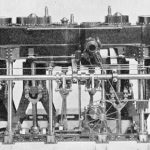With initial steam pressures above 100 lbs. per square inch, the variation of temperature in each cylinder of an ordinary compound engine again becomes great, so that the full economy due to the high pressure cannot be attained in consequence of the loss from liquefaction. It was therefore soon found desirable to extend the compound system, and divide the expansion into three stages, carried out in separate cylinders, so as to reduce the range of temperature in each.
Engines on this system are usually known as triple expansion or triple compound engines. They were first introduced by the late Dr., then Mr., A. C. Kirk, of Messrs. R. Napier & Sons, Glasgow, who, in 1874, fitted them on board the s.s. ‘Propontis,’ to utilise steam of 150 lbs. pressure, supplied by Rowan & Horton’s water-tube boilers. These engines gave good economical results, but the boilers unfortunately gave trouble, and were ultimately taken out. Very little further was done in this direction, until, in 1881, Mr. Kirk fitted a set of triple expansion engines on board the s.s. ‘Aberdeen,’ for the trade to Australia and China. The results in this instance were so satisfactory that other engines of the same type followed, and the system was soon largely adopted in the mercantile marine.
Since 1885 the new ships for the Royal Navy have been fitted with triple expansion engines, which type is now the most general for marine purposes. The steam pressure first used with them in the Navy was 130 lbs., which was gradually increased to 155 lbs. in the year 1887. From this date to 1895 large numbers of triple expansion engines were added to the Navy, all with 155 lbs steam pressure. In the mercantile marine, however, 180 lbs. steam pressure is now largely used, and in many cases 200 lbs.
In the two large cruisers ‘Powerful ‘ and ‘Terrible,’ commenced in 1893, and tried in 1896-97, a boiler pressure of 260 lbs. is adopted, reduced to 210 lbs. at the engines, while in cruisers of 1895, and subsequently, these pressures have been increased to 300 and 250 lbs. respectively. Triple expansion engines are fitted, the low-pressure cylinders being divided into two parts.
The gain in economy effected by the triple expansion engine, worked with steam of 130 lbs. to 150 lbs. pressure, over the ordinary compound engine worked at 90 to 100 lbs. pressure, may be taken at from 15 to 20 per cent., while with the higher pressures it will be still greater. Figs. 11 and 12 show the general arrangement of a triple expansion engine





